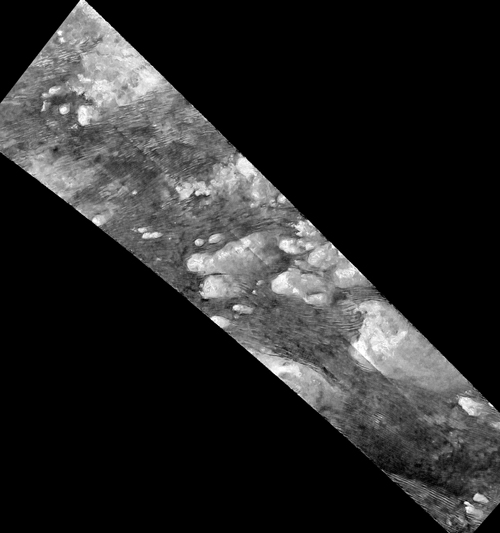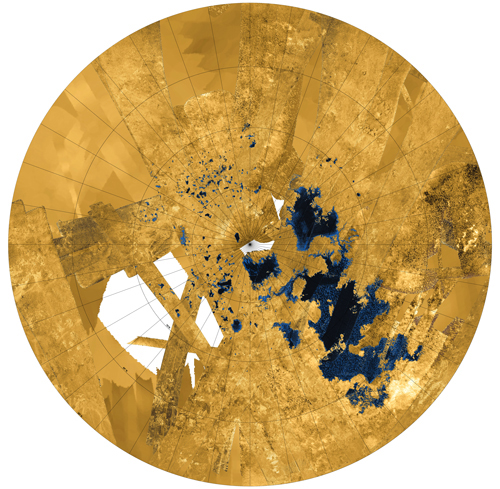Since the Cassini spacecraft entered Saturn’s orbit in 2004 and dropped a probe onto its largest moon, Titan, scientists have been captivated. Titan’s icy surface is dotted with lakes and seas, its equator wrapped in a field of dunes. Its rainstorms are eerily Earth-like, and its atmosphere swells with prebiotic chemistry.
But in a few short months, Cassini will vaporize in Saturn’s atmosphere, and scientists will wave goodbye to studying Titan up close.
“It’s going to be a very emotional next several months.”
“It’s going to be a very emotional next several months,” said Elizabeth “Zibi” Turtle, a planetary scientist at Johns Hopkins University’s Applied Physics Laboratory (JHUAPL) in Laurel, Md. Turtle, along with about 60 other scientists inside and outside the Cassini mission, gathered at NASA’s Goddard campus in Greenbelt, Md., in early April for the fourth Titan Through Time workshop.
There, presenters covering Titan from its interior all the way to the top of its thick atmosphere reminded us that before Cassini’s September demise, there’s still plenty of fun in store.
On 22 April, for example, the spacecraft will sideswipe Titan and skim its ionosphere a little less than 1000 kilometers away from its surface. This flyby, designated T-126, will be Cassini’s last close trip to Titan. After 22 April, Cassini’s subsequent flybys of Titan will be from hundreds of thousands of kilometers away while it swings in and out of Saturn’s rings.
In the past 13 years, “Titan went from being a mystery, which is exciting, to being a frontier to explore,” Turtle said. With these last views of Titan—both near and far—scientists hope to see the bottom of its lakes, improve their maps of the north pole, and even spot some storm clouds.
A Strange Surface
Cassini didn’t give us our first glimpse of Titan. That came from the Voyager spacecraft, which passed by Saturn in 1980 and 1981. But Voyager couldn’t see down to Titan’s surface: Those views came only with Cassini and the short-lived Huygens probe.

During Cassini’s fourth flyby in 2005, its radar instrument revealed wind-swept dunes wrapping around Titan’s equator. Dunes are exciting because they “can be an instantaneous marker for climate and wind,” said Jani Radebaugh, a planetary scientist at Brigham Young University in Provo, Utah. A dune’s shape can, on Earth at least, reveal which way the wind is blowing.
However, as with most things on Titan, even the discovery of dunes raised more questions. Currently, the sand looks like it’s moving one direction, but climate models show the wind is blowing in a different direction, Radebaugh said. And when observations and models don’t match up, scientists know that they should search for more clues.
Dunes aren’t the only unexpected feature dotting Titan’s cold landscape. Early in the mission, scientists also discovered dark patches of liquid: lakes and seas. Thanks to Cassini’s infrared spectrometer and other instruments, scientists know that these lakes are filled with liquid methane, ethane, other more complex hydrocarbons, and possibly nitrogen.
What’s more, scientists recently spotted waves on the surface of Punga Mare, a northern lake, which can tell them something about Titan’s winds and whether a future submarine exploration mission would splash or splat.
High Hopes for T-126

Thus far, however, the angle of Titan flybys hasn’t allowed the spacecraft to see the bottoms of Titan’s smaller lakes.
Scientists hope that T-126 will change that, said Marco Mastrogiuseppe, a telecommunications engineer at Sapienza University in Rome. During the last close flyby, Cassini scientists will aim its radar at the northern lakes to peek at their depths.
T-126 could also help illuminate the lakes’ origins, Mastrogiuseppe said. Could they form like sinkholes on Earth, where rain and groundwater dissolve rock from above and below? Or could there be a tectonic origin, perhaps involving rifts opening basins and liquid rushing in? Scientists also suspect there could be a subsurface network connecting the lakes and seas, but they aren’t yet sure.
Zooming Out to the Big Picture
Even Cassini’s subsequent far-off flybys, from hundreds of thousands of kilometers away, will help scientists better understand Titan’s lakes and seas.
Even Cassini’s subsequent far-off flybys, from hundreds of thousands of kilometers away, will help scientists better understand the lakes and seas, said Conor Nixon, a planetary scientist at NASA’s Goddard Space Flight Center and one of the original cofounders of the Titan Through Time workshops.
From up close, the radar can show scientists small patches in high resolution as the spacecraft zooms by, but it can’t get wide shots of the entire region. Imagine driving by a house at 100 kilometers per hour and snapping a picture. There isn’t much time to get a complete view. But driving by from 100 kilometers away, you’d have more time to snap multiple pictures, Nixon said.
Similarly, during the faraway flybys, Cassini will sail over Titan’s north pole and spend hours capturing radar images of the entire region, Nixon said. These images will allow scientists to improve their maps and watch for changes along the lakes’ and seas’ shorelines.
An Active Atmosphere
As a scientist who works with Cassini’s remote sensing instruments, Turtle actually prefers the faraway flybys. The reason is because, from farther away, Cassini’s infrared mapping instrument and high-resolution camera can also capture a more complete profile of the atmosphere, Turtle said.
And Titan’s atmosphere is quite the mystery. Titan is the only large moon in the solar system swaddled in a thick atmosphere, and the Huygens probe revealed that it’s dominated by nitrogen, like Earth’s. Likewise, Titan is the only other body in the solar system with liquid on its surface. Plus, Titan boasts liquid cycling akin to Earth’s hydrologic cycle, although in Titan’s case, it’s primarily methane that gets evaporated, condenses in the atmosphere, and precipitates as rainstorms that erode and shape the surface.
Titan’s atmosphere could hold clues to life-generating chemistry.
But scientists have no idea how Titan’s atmosphere got there or what replenishes its nitrogen and its methane, another major constituent of the atmosphere. One particularly surprising find from Cassini was the upper atmosphere’s complex organic molecules, Turtle said. No one expected to see benzene rings or long, complex chains of hydrogen and carbon.
Another surprising find in Titan’s upper atmosphere was heavy ions, said Sarah Hörst, an atmospheric chemist at Johns Hopkins University in Baltimore, Md. Heavy ions are key ingredients to prebiotic chemistry, which means Titan’s atmosphere could hold clues to life-generating chemistry.
A Future Window into Titan’s Skies
In May, scientists will recruit an Earth-based system to help them observe Titan’s atmosphere. Nixon and his team have scheduled time to observe Titan using the Atacama Large Millimeter/submillimeter Array (ALMA) observatory in northern Chile’s Atacama Desert.
The May observation will match up with one of the closer of the distant Cassini flybys, Nixon said, and will allow scientists to look for an even wider range of molecules in Titan’s atmosphere. This is because some molecules can be viewed only in certain wavelengths, beyond the capabilities of Cassini’s instruments. Using ALMA will allow researchers to see molecules that might be invisible to Cassini.
This simultaneous observation will give scientists a benchmark set of data that will allow them to continue to observe Titan’s atmosphere decades into the future, Nixon said, while they look for more prebiotic signatures, like sulfur, or a molecule called vinyl cyanide that could form cell-like membranes in Titan’s liquid oceans and lakes.
A Portal to Data
Even after Cassini ends, scientists will still be digging for clues, said astronomer Trina Ray from NASA’s Jet Propulsion Laboratory (JPL) in Pasadena, Calif. Ray, along with her colleagues at JPL, has made it her mission to ensure that future scientists can use the mountains of data that Cassini has beamed to Earth.
Cassini scientists upload their raw data into an online database called the Planetary Data System, which scientists even outside the mission can use. But these data aren’t necessarily formatted in an intuitive way for those scientists, Ray said. So she cofounded a group that is puzzling out ways to help future scientists interpret Titan data specifically. She presented at the Titan Through Time workshop to solicit input from scientists studying Titan about how to aggregate all the data.
The idea is to build a Cassini “master timeline.”
One of the ideas is to build a Cassini “master timeline,” Ray said, a narrative that could help guide future scientists through the mission. This timeline would include more than times, dates, and instrument information: It would include details about the intent of an activity. Why was Cassini’s camera pointing here; why was the infrared instrument pointed there?
Ray and her team have also considered a strategy that would incorporate Titan data into a ready-to-use platform like Mars Trek, an interactive, publicly available map that layers data from various Mars missions and their landing sites. Mars Trek users can toggle between layers, explore the different sites, and save and share what they’ve found with others. Ray imagines a similar map for Titan, where scientists or users could flip through layers of data from Cassini’s different instruments.
Mysteries Within Mysteries
In the subsequent seven flybys of Titan before the end of Cassini, Turtle and her team will be looking for clouds over the moon’s northern hemisphere. All the climate models predict that large storm clouds should form over Titan’s high northern latitudes as Titan enters its long summer. But so far, no clouds have appeared, another sign that the hunt for clues isn’t over.

“Titan has really been teasing us with the clouds,” Turtle said.
Turtle may not glimpse the elusive clouds. And maybe T-126 won’t provide answers to long-standing questions about Titan’s lakes. The end of Cassini’s mission means no more sniffing the atmosphere with spectrometers, no more close-up images of meandering dunes, and no new views of its mysterious seas.
But the workshop ended optimistically, with scientists turning their focus to a future Titan mission. Perhaps a drone-like quadcopter could fly around Titan’s surface, researchers mused, taking data from multiple research sites. Or a submarine could swim through a sea.
And whatever new information comes to light will inevitably generate more questions.
“That’s the other thing that’s been really fun about [studying Titan]: mysteries within mysteries,” Turtle said.
—JoAnna Wendel (@JoAnnaScience), Staff Writer
Citation:
Wendel, J. (2017), What to expect from Cassini’s final views of Titan, Eos, 98, https://doi.org/10.1029/2017EO072195. Published on 20 April 2017.
Text © 2017. The authors. CC BY-NC-ND 3.0
Except where otherwise noted, images are subject to copyright. Any reuse without express permission from the copyright owner is prohibited.

